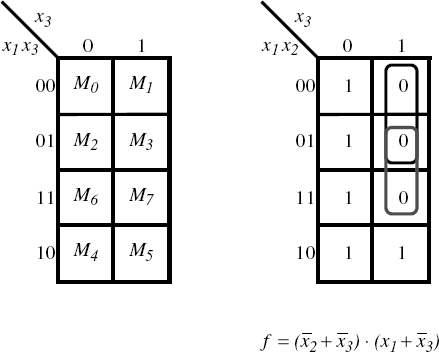6.7 FIVE-VARIABLE KARNAUGH MAP
A five-variable Karnaugh map can be constructed using two four-variable Karnaugh maps. Imagine a map like those drawn previously, with an identically sized map stacked directly on top of the other. The two halves are distinguished by the fifth variable, which can be equal to 0 or 1. Since it is difficult to draw a three-dimensional object on two-dimensional paper, a five-variable Karnaugh map can have both parts drawn side by side as illustrated in Figure 6.9.
The logic function mapped into the Karnaugh map of Figure 6.9 has five variables. The two groups of four 1's shown in the upper right corners of each map section can be circled as one group and denote the product term ![]() . Since the 1's appear in both maps when x5 = 0 and x5 = 1, they do not depend on x5. The same is true for the pair of 1's in the vertical line in both maps. The last 1 appears only in the x5 = 1 and hence gives the largest product term, as seen in the final function of f.
. Since the 1's appear in both maps when x5 = 0 and x5 = 1, they do not depend on x5. The same is true for the pair of 1's in the vertical line in both maps. The last 1 appears only in the x5 = 1 and hence gives the largest product term, as seen in the final function of f.

Figure 6.9 Karnaugh Map Simplification of a Five-Variable Logic Function

Figure 6.10 Karnaugh Map Simplification of a Two-Variable POS Logic Function
All the Karnaugh map examples illustrated earlier used the sum-of-products ...
Get Introduction to Digital Systems: Modeling, Synthesis, and Simulation Using VHDL now with the O’Reilly learning platform.
O’Reilly members experience books, live events, courses curated by job role, and more from O’Reilly and nearly 200 top publishers.

